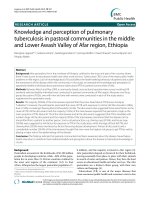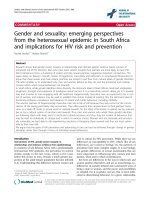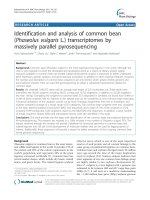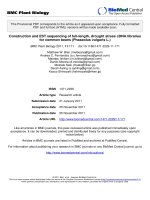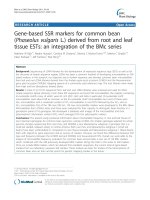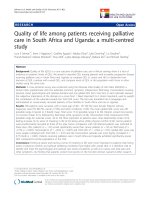Diversity in farmers’ varieties (landraces) of common bean (phaseolus vulgaris l , fabaceae) in south wollo and east gojjam zones of amhara region, ethiopia
Bạn đang xem bản rút gọn của tài liệu. Xem và tải ngay bản đầy đủ của tài liệu tại đây (3.11 MB, 129 trang )
Diversity in Farmers’ Varieties (Landraces) of Common Bean
(Phaseolus vulgaris L., Fabaceae) in South Wollo and East
Gojjam Zones of Amhara Region, Ethiopia
Menbere Berhane G/Egziabehar
Addis Ababa University
Addis Ababa, Ethiopia
June, 2017
Diversity in Farmers’ Varieties (Landraces) of Common Bean
(Phaseolus vulgaris L., Fabaceae) in South Wollo and East
Gojjam Zones of Amhara Region, Ethiopia
By: Menbere Berhane G/Egziabehar
A Thesis submitted to
The Department of Plant Biology and Biodiversity Management
Presented in Partial Fulfillment of the Requirements for the Degree of
Master of
Science in Plant Biology and Biodiversity
Management
Addis Ababa University
Addis Ababa, Ethiopia
June, 2017
ADDIS ABABA UNIVERSITY
GRADUATE PROGRAMMES
This is to certify that the Thesis prepared by Menbere Berhane G/Egziabehar, entitled:
“Diversity in Farmers‟ Varieties (Landraces) of Common Bean (Phaseolus vulgaris L.,
Fabaceae) in South Wollo and East Gojjam Zones of Amhara Region, Ethiopia” and
submitted in partial fulfillment of the requirements for the degree of master of science in
Plant Biology and Biodiversity Management complies with the regulations of the
University and meets the accepted standards with respect to originality and quality.
Approved by Examining Board:
Name
Signature
1.
(Examiner)
2.
(Examiner)
Date
3. Prof. Zemede Asfaw (Advisor)
4. Prof. Zerihun Woldu (Advisor)
5. Dr. Berhanu Amsalu (Co- Advisor)
6.
(Chairman)
ii
Abstract
Diversity in Farmers‟ Varieties of Common Bean (Phaseolus vulgaris L., Fabaceae) in
South Wollo and East Gojjam Zones of Amhara Region, Ethiopia
Menbere Berhane G/Egziabehar, MSc. Thesis
Addis Ababa University, June 2017
This study was conducted on common bean (Phaseolus vulgaris L., Fabaceae) varieties identified
by farmers of South Wollo and East Gojjam. The field study was conducted in two of the main
production areas of the species f o c u s i ng o n 12 kebeles (smallest administrative units)
distributed in six districts within the two zones of South Wollo and East Gojjam of Amhara
Region. The main objective of the study was to investigate on the diversity of common bean
landraces (farmers’ varieties) and to know the ethnobotanical values of the crop. The field study
was carried out between October 2016 and January 2017. A total of 168 informants comprising
144 general informants and 24 key informants (84 men and 84 women) aged between 19 and 75
years were interviewed. Structured interviews with general informants and semi-structured
interviews with key informants, field observations, guided field walk and market surveys were
used to collect information at the household level and at market places. Descriptive statistics,
informant consensus, preference ranking, ANOVA (analysis of variance), Shannon-Wiener
diversity index and t-test were employed for the analysis of the data by using R-software (Rstudio) v 3.2.2 and MS Excel 2016 spread sheet. The findings are presented in tables, figures and
words. A total of 69 common bean landrace seed samples were collected. The majority of the
farmers gave names to their varieties based on morphological traits, seed color, seed taste and
maturity time. Interview results indicated that the majority (80%) of the informants asserted that
they cultivate local landraces, of which seven distinct farmer-named types of common bean
landraces were sorted out. Common bean landraces were mainly cultivated as a sole crop but
intercropping was also practiced. The dominant landraces were NECH BOLOQE in the four strata
(SM3 of S. Wollo, M2 of S. Wollo, M3 of E. Gojjam and M2 of E. Gojjam) ranging from 70 to 40
% followed by KEYE BOLOQE and DALECHA BOLOQE. TEKUR BOLOQE was found (12 % of
occurrence) in M2 of S. Wollo. Informants showed that common bean is an important food item
mainly consumed in the form of SHIRO (fine ground grains used in the making of sauces), KIK
(split grains for sauce making) and NIFRO (boiled grains). Uses of common bean varieties for
human consumption and income generation have statistically significant difference (p<0.05)
among varieties. NECH BOLOQE was shown to be extremely important for income generation
(98%) whereas KEYE BOLOQE and TEKUR BOLOQE were said to be important for human
consumption. The grains of this crop were among the important marketed grains in the local
markets at kebele and district levels. Moreover, farmers showed that common bean is an
important crop for animal feed, agroecological intensification through intercropping and crop
rotation, as medicine and the flowers are foraged by honeybees. Varieties varied significantly
(P<0.05) in their resistance to diseases and pests. However, there is no statically significant
difference (P>0.05) in resistance to frost among varieties both in S. Wollo and E. Gojjam. The
study has confirmed the essential role that traditional farmers play in the development and
maintenance of common bean landraces and therefore farmers’ practices need to be backed up
and enhanced for effective conservation of the genetic resources found in the study area and
elsewhere in the country. Education and awareness raising of the local farmers and further
research are needed in order to maintain the landrace diversity and the genetic resources of
common bean.
Key words: Common bean, diversity, landrace/farmers‟ variety, Ethiopia, farmers‟ knowledge
iii
Acknowledgements
First of all, I am greatly indebted to express my gratitude to my major research advisors
Prof. Zemede Asfaw and Prof. Zerihun Woldu and co-advisor Dr. Berhanu Amsalu
(EIRP) for their continued guidance, inspiration, encouragement and support throughout
the study period which made the completion of this study smooth and successful. The
constructive criticisms and valuable suggestions they gave me during planning the
research work as well as doing the fieldwork and write up of the thesis were pivotal for
my ultimate success. I also thank Mr. Demeke Nigussie (GIS expert) who made the maps
of the study areas and Dr. Morgan L. Ruelle and Prof. Alison Power for helping me on
statistical data analysis and all the technical support. I would like to express my special
and deepest gratitude to AAU Female Scholarship that sponsored me to study my M.Sc.
and the McKnight Foundation for their financial, material and training support.
I acknowledge all the farmers, local people, zonal and district agricultural and rural
development offices for their support, to have positive cooperation from local leaders,
people and development workers. Melkasa Agricultural Research Center to do on-station
trial and Ethiopian Biodiversity Institute to conduct germination test are also
acknowledged.
It is my pleasure and honor to sincerely express my gratefulness and indebtedness to my
family members as a whole, who received all suffers while I was in my academic and
research work. They were with me and paid all sacrifices required for the success of my
academic and research studies. Especially, words of genuine encouragement, entire
support, affection, and prayers served me as a source of strength, inspiration and impetus
throughout the study period.
I extend my thanks to the Department of Plant Biology and Biodiversity Management
and all the staff members and students in the Department and my friends for their moral
support and good friendship. Above all, I would like to thank the almighty God and His
mother St. Merry for their limitless assistance, care and made all things possible for me to
finish this study
iv
Table of Contents
Page
List of Figure ................................................................................................................................ ix
List of Tables ................................................................................................................................ xi
List of Appendices ....................................................................................................................... xii
Acronyms .................................................................................................................................... xiii
CHAPTER ONE ........................................................................................................................... 1
1. INTRODUCTION..................................................................................................................... 1
1.1. Background of the study .......................................................................................................... 1
1.2. Statement of the problem, Research questions, Hypotheses and Research objective ............. 3
1.2.1. Statement of the problem .................................................................................................. 3
1.2.2. Research questions ............................................................................................................ 4
1.2.3. Research hypotheses ......................................................................................................... 5
1.2.4. Objectives .......................................................................................................................... 5
CHAPTER TWO .......................................................................................................................... 7
2. LITERATURE REVIEW ........................................................................................................ 7
2.1. Botanical description of common bean.................................................................................... 7
2.2. Origin and domestication of common bean ............................................................................. 8
2.3. Taxonomic description of common bean ................................................................................. 8
2.4. Farmers‟ varieties (landraces) diversity ................................................................................... 9
2.5. Adaptability of common bean ................................................................................................ 10
2.6. Cultivation of common bean .................................................................................................. 11
2.7. Distribution of common bean in the world and in Ethiopia................................................... 11
2.8. Agroecological requirements of common bean ..................................................................... 12
v
2.9. Uses of common bean ............................................................................................................ 13
2.10. World production of common bean ..................................................................................... 14
2.11. Production constraint ........................................................................................................... 15
CHAPTER THREE .................................................................................................................... 16
3. MATERIALS AND METHODS ........................................................................................... 16
3.1. Description of the study area ................................................................................................. 16
3.1.1. Climate of the study area ................................................................................................. 18
3.2. Materials ................................................................................................................................ 19
3.3. Methods.................................................................................................................................. 19
3.3.1. Site selection ................................................................................................................... 19
3.3.2. Informant selection .......................................................................................................... 21
3.3.3. Field data collection ........................................................................................................ 23
3.3.4. Ethnobotanical data collection ........................................................................................ 23
3.3.5. Interview.......................................................................................................................... 23
3.3.6. Market survey.................................................................................................................. 25
3.3.7. Field observation ............................................................................................................. 25
3.3.8. Seed collection methods .................................................................................................. 25
3.3.9. Standard germination test (%) ......................................................................................... 26
3.3. Data analysis methods............................................................................................................ 27
3.3.1. Descriptive statistics ........................................................................................................ 27
3.3.2. Shannon-Wiener diversity index ..................................................................................... 27
3.3.3. Beta diversity................................................................................................................... 28
3.3.4. Preference ranking........................................................................................................... 28
vi
3.3.5. Analysis of Variance (ANOVA) ..................................................................................... 28
3.3.6. T- test............................................................................................................................... 29
CHAPTER FOUR ....................................................................................................................... 29
4. RESULTS ................................................................................................................................ 30
4.1. Common bean landrace diversity........................................................................................... 30
4.2. Total area planted with common bean ................................................................................... 35
4.3. Diversity and landrace richness ............................................................................................. 37
4.4. Yield of common bean varieties in South Wollo and East Gojjam ....................................... 39
4.5. Yield of common bean during drought, waterlogging and shortage of rainfall..................... 41
4.6. Common bean landrace collection in the study area ............................................................. 43
4.7. Common bean cultivation, Cropping systems and Management practices ........................... 43
4.7.1. Common bean cultivation ............................................................................................... 43
4.7.2. Cropping system .............................................................................................................. 46
4.7.3. Management practices ..................................................................................................... 47
4.8. Importance of common bean in the study area ...................................................................... 49
4.8.1. Importance of common bean as a Food, Feed, Source of Income, Medicine and
Bee forage. ................................................................................................................................ 49
4.8.2. Importance of common bean in Agroecological Intensification ..................................... 54
4.8.3. Preferences of Farmers‟ .................................................................................................. 56
4.8.4. Production constraint of common bean ........................................................................... 57
4.9. Local Farmers Perception about common bean ..................................................................... 58
4.10. Seed Source, Selection, Storage and Management Practices .............................................. 59
4.11. Gender Roles for Maintaining the Landrace Diversity of common bean ............................ 61
vii
4.12. Resistance of common bean varieties to pest, frost and disease .......................................... 62
4.13. Germination percentage ....................................................................................................... 64
4.14. Market prices of farmers‟ varieties ...................................................................................... 66
CHAPTERFIVE ......................................................................................................................... 69
5. DISCUSSION, CONCLUSIONS AND RECOMMENDATIONS ..................................... 69
5.3. Discussion .............................................................................................................................. 69
5.3.1. Diversity of farmers‟ varieties......................................................................................... 69
5.3.2. Cropping and cultivation systems ................................................................................... 70
5.3.3. Place of common bean grown ......................................................................................... 72
5.3.4. Management Practices..................................................................................................... 72
5.3.5. Importance of common bean in the study areas .............................................................. 73
5.3.6. Local farmer‟s perception about common bean .............................................................. 76
5.3.7. Market prices of farmers‟ varieties ................................................................................. 77
5.3.8. Production constraint of common bean ........................................................................... 78
5.4. Conclusion ............................................................................................................................. 80
5.5. Recommendation ................................................................................................................... 82
REFERENCES............................................................................................................................ 84
APPENDICES ............................................................................................................................. 94
viii
List of Figures
Page
Figure 1: Map of Ethiopia showing the study area Climate of the study are.................... 17
Figure 2: Climate diagram of the study area in South Wollo and East Gojjam Zones of
Amhara Region (Data source: EMA) ............................................................................... 19
Figure 3: Schematic diagram of sampling Kebeles within districts and different categories
of informants ..................................................................................................................... 22
Figure 4: Interview with informants ................................................................................. 24
Figure 5: Photos of farmers‟ varieties of common collected from the study area ............ 34
Figure 6: Total area of common bean planted in S. Wollo and E. Gojjam and by wealth 36
Figure 7: Area planted by common bean in each agroecological zone ............................ 36
Figure 8: Dominant landrace in each stratum. .................................................................. 37
Figure 9: Shannon diversity index based on count of farmers. ......................................... 39
Figure 10: Yield of common bean in 2007 and 2008 E. C in S. Wollo and E. Gojjam.... 40
Figure 11: Yield of common bean varieties during drought (A), shortage of rainfall (B)
and waterlogging (C) ........................................................................................................ 42
Figure 12: Map of study area showing seed collection site of common bean Farmers‟
Varieties . .......................................................................................................................... 43
Figure 13: Common bean planting area in S. Wollo and E. Gojjam ................................ 44
Figure 14: Planting time in the four strata. ....................................................................... 45
Figure 15: Harvesting time in the four strata. ................................................................... 46
Figure 16: Intercrop common bean with other crop. ........................................................ 47
Figure 17: Use of common bean within strata. ................................................................. 50
Figure 18: Use of common bean varieties for consumption and income generation........ 53
Figure 19: Advantage of crop rotation of common bean with other crops control. .......... 54
ix
Figure 20: Rotation of common bean with other crop. ..................................................... 56
Figure 21: Sources of common bean seeds ....................................................................... 59
Figure 22:Wealth of farmers in relation to varieties used................................................. 60
Figure 23: Photo of traditional Seed storage containers( GOTER OR GOTA) in S. Wollo
(A) ..................................................................................................................................... 61
Figure 24: Gender role in common bean process S. Wollo .............................................. 62
Figure 25: Gender role in common bean process E. Gojjam ............................................ 62
Figure 26: varieties of common bean resistance toward pest and a photo which is the pod
of common bean affected by pest ................................................................................... 63
Figure 27: varieties of common bean resistance to frost .................................................. 64
Figure 28: varieties of common bean resistance to disease .............................................. 64
Figure 29: photo of germination trials in EBI (photo by Menbere Berhane, April/2017) 66
Figure 30: Market price of common bean varieties in the study area ............................... 67
Figure 31: Market price of common bean landrace varieties in the study Weredas ......... 67
x
List of Tables
Page
Table 1: Description of the study area .............................................................................. 17
Table 2: Regions, Zones, Weredas, Kebeles and Agroecological zones used in the study
area. ................................................................................................................................... 20
Table 3: Number of Accessions from two Zone, their local names and relative meanings.
........................................................................................................................................... 30
Table 4: Vernacular names of common bean farmers‟ varieties in study area and their
meanings. .......................................................................................................................... 32
Table 5: Shannon diversity index by strata ....................................................................... 38
Table 6: Gamma, Alpha and Beta diversity of farmers‟ varieties among in the four strata
........................................................................................................................................... 38
Table 7: Mean yield, standard deviation(SD) and standard error (SE) 2007.................... 41
Table 8: Mean yield, standard deviation(SD) and standard error (SE) 2008.................... 41
Table 9: Common bean use values ................................................................................... 51
Table 10: Common bean foods and their preparation ....................................................... 52
Table 11: Major Crop Rotation Practices by Farmers in the Study Zones. ...................... 55
Table 12: Farmers' preference ranking for use value of common bean ............................ 56
Table 13: Germination percentage of common bean varieties ......................................... 65
xi
List of Appendices
Page
Appendix 1: Interview data collection format for general informant .............................. 94
Appendix 2: Interview data collection format for key informant .................................... 99
Appendix 3: Market survey data collection schedule .................................................... 101
Appendix 4: Common bean Seed passport descriptor ................................................... 102
Appendix 5: Seed collection, interview and market site................................................ 104
xii
Acronyms
AEZ
Agroecological Zone
ANOVA
Analysis of Variance
CIAT
International Center for Tropical Agriculture
COMESA
Common Market for Eastern and Southern Africa
CSA
Central Statistical Agency
EBI
Ethiopia Institute of Biodiversity
E. Gojjam
East Gojjam
FAOSTAT
Food and Agriculture Organisation of the United Nations (FAO)Statistics
GIS
Geographical information System
SSA
Sub Saharan Africa
S. Wollo
South Wollo
SM3
Tepid sub moist mid highland
M2
Warm moist lowland
M3
Tepid moist mid highland
NMSA
National Meteorological Service Agency
ODK
Open Data Kit
xiii
CHAPTER ONE
1. INTRODUCTION
1.1. Background of the study
Legume seeds are an important staple foods and sources of dietary minerals that
potentially provide all of the 15 essential minerals required by humans. Common bean
(Phaseolus vulgaris) is the most vital grain legume for direct human consumption. The
species has high diversity as seen in its morphological variability, uses and growth habits
and patterns (Baeta et al., 2010; Heuze et al., 2013). In the study area, common bean is
known as BOLOQE in the local Amharic language. Other names of the crop include dry
bean, bean, kidney bean, haricot bean, French bean and field bean. It is a particularly
important legume crop grown worldwide. It grows best in warm climates at temperatures
of 18 to 24°C (Gebre-egziabher Murut et al., 2014).
This crop is currently estimated to be one of the most important legumes worldwide and
it is described as a nearly "perfect" food. Nutritionally rich, it is also a good source of
protein, dietary fiber and complex carbohydrates (Pachico, 1993) and it is an important
source of nutrients for more than 300 million people in parts of Eastern Africa and Latin
America, representing 65% of total protein consumed, 32% of energy and a major source
of micronutrients, e.g., iron, zinc, thiamin and folic acid (Petry et al., 2015). It is also
important in Nitrogen fixation thus improving the soil fertility as well as increasing crop
production and improving the livelihoods of farmers ( Gebre-egziabeher Murut et al.,
2014). It is described as a non-sensitive crop to soil as long as it is well-drained and
fertile (Rahman et al., 2014). It can be grow successfully on most soil types, from light
1
sands to heavy clays, but friable, deep and well-drained soils are best preferred (Gifole
Gidago et al., 2011).
According to Margaret et al. (2014), common bean in Sub-Saharan Africa (SSA) is an
important crop for food-security and nutrition. It plays a big dietary role, supplying
proteins, carbohydrates, essential elements and vitamins to both rural and urban
households. It is estimated that the crop meets more than 50% of dietary protein
requirements of households in SSA. The annual per capita consumption is higher among
low-income people who cannot afford to buy nutritious food stuff, such as meats and fish
(Arenas et al., 2013).
Common bean is also a major food and cash crop in Ethiopia as well and it has
considerable national economic significance. It is often grown as cash crop by small scale
farmers and used as a major food legume in many parts of the country where it is
consumed in different types of traditional dishes (Kedir Oshone et al., 2014). For a very
long time, it has been cultivated as a field crop. Moreover, for more than 40 years it has
been an export crop (Rahmeto Negash, 2007). It is cultivated in a wide range of agroecologies and farming systems including well-watered and drought-stressed areas (Asrat
Asfaw et al., 2009).
This crop is distributed and grown in different parts of Ethiopia depending on climatic
and socio-economic factors and is being part of the diets of the farming households; it
serves as a source of protein to supplement the protein deficient main dishes like maize
and Enset in the southern parts of the country especially in Wolaita and Sidama areas.
Besides, the farmers also grow common bean to use the straw as forage for livestock,
2
source of fuel, mulching, bedding, and covering material for houses of poor farmers
(Kefyalew Dagnew et al., 2014). In Ethiopia, the major common bean producing areas
are central, eastern and southern parts of the country (Hirpa Legesse et al., 2013).
Common bean production has been practiced in all Regions of Ethiopia. Oromia (43%),
Amhara, SNNPR, Benishangul-Gumuz and Tigray Regions are the major producing
Regions that contribute more than 99 percent of the total production. Among the major
bean producing zones, which provide more than 50 percent of their produce for market
are East Gojjam (63%), East Showa (53%). West Arsi, South Gonder and South Wollo
provide more than 40% of their produce for market. These areas are the major surplus
producing area of white beans and almost all beans that are used for export purposes are
collected from these areas (Frehiwot Mulugeta, 2010).
1.2. Statement of the problem, Research questions, Hypotheses and Research
objective
1.2.1. Statement of the problem
Even though common bean is an important food security crop, the production of the crop
is inconsistent due to biotic and abiotic stresses. However, integration of Phaseolus
vulgaris with the current farming system using native farmers‟ varieties can make a
significant contribution to improving soil fertility and productivity, improving dietary
quality and reducing susceptibility to the effects of climate change (Zeven, 1998).
Reservoirs of useful genetic diversity of landraces need to be conserved for the
uncertainties of the future. There are few studies done in Ethiopia on beans and most of
them focus on adoption, agronomic aspects, breeding, disease resistance aimed at
3
increasing yield (Agete Jerena, 2014). However, studies on farmers‟ varieties diversity
and germplasm collection of this potential resource is important to guarantee the
improvement of the crop. Such studies can be a source of new genes for combating
different threats to agricultural production. Therefore, this study was initiated to assess
and document the landrace diversity and the ethnobotanical aspects of common bean
(Phaseolus vulgaris) in South Wollo and East Gojjam zones of Amhara Region.
1.2.2. Research questions
This research has attempted to answer the following main research questions:
What are the most preferred uses of common bean in South Wollo and East Gojjam
Zone?
What are the common bean (Phaseolus vulgaris L.) landraces found in the study area and
which ones are most commonly used by the farmers in the area?
What are the local names of the landraces of common bean and what are their respective
meanings?
What are the economic values of common bean in the study area?
How is common bean cultivated (sole cropping, intercropping, crop rotation and border
cropping) in the three agroecological zones found in South Wollo and East Gojjam
Zones?
What are the problems associated with the production of common bean in the study
areas?
What conservation and management measures are required to be undertaken for
cultivation of common bean?
4
1.2.3. Research hypotheses
There is no significant difference in the common bean landrace diversity maintained by
farmers in South Wollo and East Gojjam.
Farmers‟ varieties of common bean are ethnobotanical used for the same purposes in
South Wollo and East Gojjam zones.
Seed selection criteria and ways of traditional seed storage have no differences in South
Wollo and East Gojjam zones of the study area.
Agroecological variations do not affect the number of common bean farmers‟ varieties.
Cropping season, crop rotation pattern, benefits of crop rotation and intercropping
practices are not different among the three agroecological zones and in the four strata
(SM3-South Wollo, M2-South Wollo, M2-East Gojjam and M3-East Gojjam) in South
Wollo and East Gojjam zones.
The different farmers‟ varieties of common bean have different percentages of
germination under laboratory condition.
1.2.4. Objectives
General objective
The general objective of this study was to identify and document the landrace diversity,
distribution and ethnobotanical uses of common bean (Phaseolus vulgaris) farmers‟
varieties in South Wollo and East Gojjam Zones, Ethiopia.
Specific objectives
To identify and document the landrace diversity of common bean by recording
vernacular names reported by farmers.
5
To gather, record, analyze and document indigenous knowledge on the traditional uses,
management practices including cropping systems, beliefs, stories associated with
common bean in general and the individual landraces in particular.
To investigate the distribution of common bean farmers‟ varieties in the different
agroecological zones found in South Wollo and East Gojjam
To facilitate germplasm preservation of the landraces following suitable conservation
strategies at appropriate institution
To study the germination status and the agromorphological characters of the landraces
on station
To measure the diversity of common bean landraces for possible contributions to the
development and refinement of future management, utilization and conservation
strategies
6
CHAPTER TWO
2. LITERATURE REVIEW
2.1. Botanical description of common bean
The growth forms are of the annual climber type or sub erect herbs, leaflets are ovate or
ovate-rhombic, 4.5-15 x 2.5-10 cm, acuminate and pubescent. The inflorescence is 1several-flowered; bracteoles ovate-lanceolate, 5-6 mm long. Calyx 4-5 mm long. Corolla
white, yellowish, purple or pink; standard 1-1.5 cm long; keel spirally incurved. Pod
linear-lanceolate, c 10-20 x 1-1.5 cm, compressed, puberulous or glabrous, c 5-10-seeded.
Native in America, now cultivated throughout the world; in Ethiopia commonly grown at
intermediate altitudes and perhaps locally naturalized (Thulin, 1989).
Seeds variable in size, shape and color, as a rule oblong but also ellipsoid, globular or
kidney-shaped, laterally compressed, (6-)8-17(-20) x (4-)5-7(11) mm, white, purple,
black, ochre, brown, white, black mosaic, brown, black mosaic, light colored, purple
mosaic, light colored, red-purple mosaic, light colored, brown mosaic, light colored,
orange mosaic, and grey-brown, very small light spots, usually glossy. Hilum oblong,
sometimes elliptic, about 2-3.5 mm long, central, covered by a layer of white detachable
tissue, brownish, often surrounded by a darker colored hilum ring, with a darker colored,
often conspicuous twin-bump situated near the hilum at the opposite side of the micropyle
(Westphal, 1974; Thulin, 1989).
7
2.2. Origin and domestication of common bean
Common bean originated from the New World; two centers of origin were identified
Andean and Mesoamerican (Hornakova et al., 2003; Logozzo et al., 2007).
The
domestication
occurred
independently
in
South
America
and
Central
America/Mexico, leading to two different domesticated gene pools, the Andean and
Mesoamerican, respectively (Papa and Gepts, 2003; Petry et al., 2015).This crop is
native to Mexico and Guatemala where the greater part of the diversity of varieties is
found (Arenas et al., 2013).
Common bean is the most widely distributed of the related species and has the broadest
range of genetic resources (Gomez, 2004) and is frequently used as food crop throughout
the world, especially in Latin America and Africa. Different races have been described in
both gene pools differentiated for morph-agronomical traits.
Common bean was
introduced to Europe probably from Cuba immediately after Columbus‟s voyage/ since
the first half of the sixteenth century. It was distributed widely in all parts of Europe and
the Mediterranean area where many landraces and varieties evolved that were grown to
provide dry seed or fresh pods (Logozzo et al., 2007). The species was perhaps
introduced to the eastern part of Africa by Portuguese traders in the sixteenth century
(Wortmann et al., 2004).
2.3. Taxonomic description of common bean
Common bean is the best-known species of the genus Phaseolus in the family Fabaceae of
about fifty plant species, all native to America. After the Asteraceae and Orchidaceae, the
Fabaceae is the third largest family of flowering plants in the world and the first in
8
Ethiopia (Arenas et al., 2013). It is a family of great economic importance and very
unique in having members that can form associations with symbiotic bacteria to fix
atmospheric nitrogen (Karagkiozi et al., 2012)
The wide range of growth habits of common bean varieties has enabled the crop to fit in
the many growing situations. Among the different growth habits of common bean, the
prostrate and the bushy types achieve rapid ground cover, compete with weeds and avoid
competition (Zelalem Zewdu, 2014). Moreover, common bean is an important understory
companion crop in various intercropping systems throughout the world (Rahmeto Negash,
2007). It is planted in pure stands of single landrace, as mixed plantings of several
farmers‟ varieties, and intercropped with maize, sorghum, sweet potato, cotton, coffee and
other crops. Typically, when planted for use as vegetables, common bean is planted as a
monoculture crop (Negash Hailu et al., 2015). Under Ethiopian condition, the crop is
normally grown twice a year, the first production is during the short rainy season (April to
June) and the second is during the long rain season (July to October) (Kedir Oshone et al.,
2014).
2.4. Farmers’ varieties (landraces) diversity
Landraces have originated together with agriculture and horticulture during the past
10,000 years or so. Hence, landraces of many crops have probably been grown for
several millennia. Though landraces are commonly considered as endemic to a particular
region (Zeven, 1998). Landraces have been recognized by farmers for adaptation to
specific sets of field conditions as well as particular uses within the food system. They
are often highly variable in appearance, but they can be identified and almost always
9
have different local names. They have, as their particular characteristics, a reputation for
adaptation to local climatic conditions and cultural practices, and resistance or tolerance
to diseases and pests (Harlan, 1992). Major advantages of landraces are adaptation to
their specific agro-systems and low input requirements, and ethnic reasons are also
present in traditional agricultural practices. The genetic diversity of landraces is very
important for global biodiversity conservation for future world production (Wood &
Lenne, 1997). Landraces generally provide high yield stability and intermediate average
yields under a low input agricultural system (Zeven, 1998).
2.5. Adaptability of common bean
This crop well adapted to the range of altitude from 1200 to 2000 m above sea level
(Wortmann, 1998), and in areas with annual average rainfall of 500-1500 mm. It ideally
needs moist soil throughout the growing period. However, rainfall towards the end of the
growing periods is unwanted. It can be grown successfully on most soil types, from light
sands to heavy clays, but friable, deep and well-drained soils are best preferred (Gifole
Gidago et al., 2011). In warm climate that shows greater development in environments
with average temperature of 18 to24 °C during the growing season and a precipitation of
300 to 500 thousand millimeters throughout the crop cycle (Agete Jerena, 2014) and
excessive temperatures cause flowers to abscise, and low temperatures delay pod
production and can result in empty pods. Common bean prefers well-drained, sandy clay
or sandy loam soils, with balanced fertility and moderate acidity pH 5.8-6.5 (Ensor,
2009). In Ethiopia, common beans are concentrated in the dry and warmer parts of the
country mainly along the rift valley (IFPRI, 2010).
10
2.6. Cultivation of common bean
Common bean is cultivated in a broad variety of environments, in terms of altitude,
temperature, soil type, and moisture regime, however it is grow mainly in dry land and
rain fed conditions. It is well known that local farmers have selected farmers‟ varieties
collections that best adapt to the soil and climate conditions of the region(Aguilarbenítez, 2014). The crop is grown by subsistence farmers either as a sole crop and/or
intercropped with either cereal or tree crops. Shade tolerance and early maturity
contributes to common bean‟s prominent position as understory intercrop for sorghum,
maize, and coffee in the eastern zones of the country in which 85 % of all sorghum is
intercropped with beans. Therefore, these characteristics make it an ideal crop for
intensification of existing farming system (Rahmeto Negash, 2007).
2.7. Distribution of common bean in the world and in Ethiopia
Common bean is distributed in different parts of the world, mainly in east Africa, in east
Asia, in south Asia, Europe Central America and the Caribbean, southern Africa,
Southern and the Andean area. The world major common beans producers are India,
Brazil, Myanmar, and China. Ethiopia is the third largest producer of common beans in
Eastern and Southern Africa and the leading exporter in Africa. The country exported 40
percent of its common beans out of the total production in 2010 (FAOSTAT, 2015).
Common beans are increasingly becoming an important food security commodity
particularly among the smallholders. For instance, consumption has increased from
98,065 tons to 242,100 tons between 2004 and 2009. In addition, it is important in the
county‟s balance of payments(Gepts, 1991; Agete Jerena, 2014). The distribution of
beans in Africa is extremely dependent on rural population density and mean temperature
11

